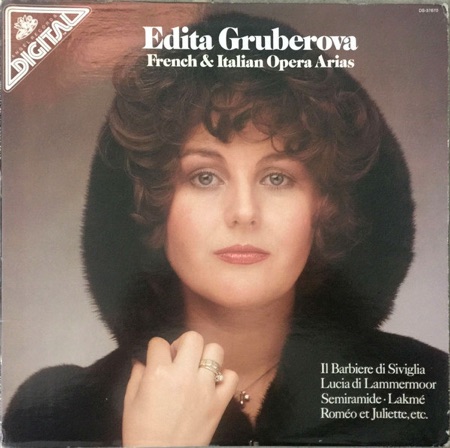

That year was the period of when my interest in opera was taken to the next level. Prior to then, my experience in listening to opera was gleaned in arias, mainly by coloraturas, from old movies on TV, featuring the likes of Jeanette MacDonald, Deanna Durbin, Kathryn Grayson and even Lily Pons (in I Dream Too Much, where I learned the Bell Song from Lakmé), and Roberta Peters (in Tonight We Sing).
The dominant coloratura opera star in America during my growing-up years, though, was Beverly Sills, who made frequent appearances on PBS and network; I adored her.
Naturally, from this steady diet of seeds, fruits, and nuts, I became a canary fancier.
Kiri Te Kanawa was the “big thing” in opera in the early 1980s, propelled by her singing “Let The Bright Seraphim” at the wedding of Prince Charles and Lady Diana. That she was be-gowned and capped like a budgerigar for the occasion piqued my interest.
Two of her LPs, a song recital and a collection of Verdi and Puccini arias were my “official” entries into the realm of “you know, serious music” (so said in the voice of Delia Flagg).
I found Te Kanawa’s voice lovely, but not very energetic or the personality especially engaging.
My two next purchases proved much more fulfilling: Frederica von Stade, a Mozart and Rossini recital, and a collection of rare Italian Opera Arias. I fell immediately in love with her voice and personality.
But I wanted some good ol’ high jinks coloratura fireworks.

Put the LP on the record player. The opening vocalise, a shining, rich tone, stronger and more substantial than I was used to in the movie coloraturas.
Then, all of a sudden…
…this absolutely hair-raising, pinpoint high E appears, seemingly from another dimension, begun softly, swelled, diminished, followed by descending staccati so rifle-shot perfect, I’m in complete flabbergast mode – “Holy shit!” For a few seconds, I actually wondered if some flute had taken over, it was so brilliantly clear and instrumental sounding.
The lovely melody that followed entranced me further: alluring, rapturous, sensual. At 3:11, the section ending with an exquisite, delicate tapering off, the tone sweet and diaphanous.
I waited in anticipation for the famous bell effects.
At 4:23. In place of the hard, aggressively hammered rat-a-tat-tat I was used to, here was Gruberova’s perfectly struck pings of diamantine but round tone, with this incredible halo of resonance, as if there were rays of light bouncing off the core of each note. The last several staccati, followed by the trill, up to the high C#, all on one breath. At 6:40, the intervallic a cappella staccati are even more brilliantly bell-like.
There are a few minor blemishes. In the slow melody the pursuit of legato has a few staccati that aren’t distinctly noted. At 6:28 is a rather swoopy set of glissandi. The high E, taken from below (which never bothered me), starts out just under the pitch, corrected by the end.
No matter. This dazzling voice and technique seized my interest on command, captivated and excited me. She was glamorous, starry, and full of vitality and shining effervescence. Adjectives galore!
Here is where I also first heard her vivid Lucia in the mad scene, her “Bel raggio lusingshier,” the scintillating “Una voce poco fa” (finished with a blazing high F), Juliette’s Waltz Song in the rarely heard key of G, the insouciant “Nobles Seigneurs!” from Les Huguenots, and especially, her riveting account of Ophélie’s mad scene from Thomas’s Hamlet.
C’est l’histoire amoureuse.
You all know the rest.

























Comments